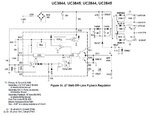Follow along with the video below to see how to install our site as a web app on your home screen.
Note: This feature may not be available in some browsers.

Usually the Auxiliary supply is added for off-line converters, in order to provide power for the dc-to-dc control IC. It is generally needed when creating a lower, isolated voltage from a higher voltage. It increases efficiency (the control IC draws its power from a stepped-down voltage) and improves reliability (the alternative, using a resistor from the input voltage to supply the capacitor, might not provide enough current at peak demand).
Hope this helps.